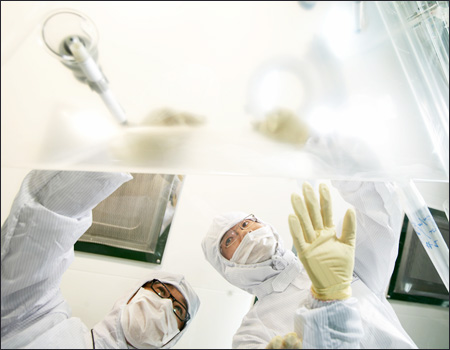Hyosung eyes new growth engines

Hyosung technicians check out the quality of TAC films at the company’s plant in the southeastern city of Ulsan, Thursday. Hyosung is diversifying its businesses for better corporate sustainability. / Courtesy of Hyosung
Hyosung Group has been built on a dual-pillar of textiles and chemicals but is now looking jump on the green technology bandwagon for future growth.
Hyosung spokesman Kim Jun-sik said renewable-energy will become a larger part of the company’s business portfolio. And carbon fiber will be a key focus in efforts to strengthen its position in existing core markets.
“Diversifying our business lineup will be important to strengthen our international profile. We need to elevate the quality of our existing products and experiment with advanced technologies at the same time,” Kim said.
The firm plans to spend up to 250 billion won (around $231 million) by 2014 in building a carbon fiber manufacturing industry in Jeonju, North Jeolla Province, and expects an annual production capacity of 2,000 tons.
Carbon-fiber-reinforced polymer, made up of millions of tiny carbon nanotubes and several times stronger and tougher than current materials, is beginning to reveal exciting industrial properties. Through 2020, Hyosung plans to spend 1.2 trillion won in carbon-fiber related businesses, a market that is growing at an annual rate of 11 percent.
“Hyosung’s target markets for carbon fiber include aerospace, robotics, wind-turbines and sports equipment. The quality of our carbon fiber just falls short of the most advanced in the world and we expect to close the gap quickly,” Kim said.
The electric vehicle (EV) business is another sector that’s been receiving more investments from the conglomerate. Hyosung said its efforts to strengthen EV-linked businesses are paying off as it’s been expanding its client base to sell more of its products.
Hyosung is providing motors for electric vehicles by Hyundai and Kia and the company is also participating in a number of state-funded projects in advancing them.
It is planning to be fast out of the gate in the market for electric car charging systems, which are to be installed in public buildings.
Another area of interest is in films used in advanced displays, with the company unveiling plans to invest 200 billion won in tri-acetyl-cellulose (TAC) film facilities through next year. TAC films are widely used for television, monitor and mobile phone screens.
Most Korean display makers, including Samsung and LG, are currently relying on Japanese partners for these products, and Hyosung wants to take a chunk of this market.
The company is confident of maintaining competiveness in its existing businesses like spandex and tire-codes. It recently completed a spandex factory in Brazil with an annual production capacity of 10,000 tons, which it believes will help develop more clients in markets like China, Vietnam and Turkey.
“The Brazil plant will allow us to strengthen our status as the world’s biggest spandex manufacturer because the demand for such products will rise ahead of the upcoming World Cup in 2014 and Summer Olympics in 2016,” Kim said.
In tire-codes, Hyosung controls 40 percent of the global demand. In 2011, the company sealed a long-term supplement partnership with Goodyear of the United States and acquired two factories.
“We will expand our global networks in what we have been doing well. Also, Hyosung will do its best to report profits from next-generation businesses,” Kim said. <The Korea Times/Kim Yoo-chul>



















































